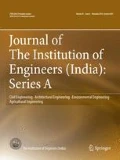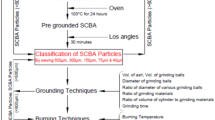Abstract
Backbone of India’s economy is agriculture. Major commodities which contribute to agriculture include sugar and alcohol. Sugar production process produces bagasse as a waste residue, which is used as fuel for boilers that produce steam for electricity generation. After burning the bagasse in boiler, the residual sugar cane bagasse ash (SCBA) is used as soil fertilizer, filling material, etc., but mostly dumped as land waste. The present study is an approach to increase the utilization of SCBA and to conserve scarcely available natural sand and energy-intensive cement. This research aims to study the feasibility incorporation of SCBA from the same source of size less than 90 microns as a replacement for ordinary portland cement (OPC) and those of size greater than 150 microns as fine aggregate (FA) replacement in cement mortar. For detailed analysis, the ash samples were subjected to field emission scanning electron microscopy (Fe-SEM), energy-dispersive X-ray (EDX) spectrometer, Fourier transform infrared (FTIR) spectrometer and sieve analysis. Mortars with SCBA as OPC and FA replacement were casted separately, and mechanical tests were carried out. The results indicated that the SCBA samples showed physical properties similar to those of OPC and FA. Relationship between cube and cylinder compressive strength was also derived. Relationship between compressive strength and water-to-binder (W/B) ratio is derived and compared with previous empirical studies. The blended mortars produced with SCBA in place of OPC and FA showed enhanced mechanical results compared to that of reference samples.












Similar content being viewed by others
References
K. Ganesan, K. Rajagopal, K. Thangavel, Evaluation of bagasse ash as supplementary cementitious material. Cem. Concr. Compos. 29, 515–524 (2007)
A. Sales, S.A. Lima, Use of Braziian sugar cane bagasse ash in concrete as sand replacement. Waste Manag. 30, 1114–1122 (2010)
“Sugar: World Markets and Trade”. United states Department of Agriculture (USDA), Foreign Agriculture Services, May 2018
S. Yoshizawa, M. Tanaka, A.V. Shekdar (eds.), Global trends in waste generation, in: Recycling, Waste Treatment and Clean Technology (TMS Mineral, Metals and Materials Publishers, Madrid, 2004), pp. 1541–1552
“Handbook on Indian Sugar Mills Association”, Indian Sugar Mills Association (ISMA) (2018)
F.M. Martinera Hernández, B. Middeendorf, M. Gehrke, H. Budelmann, Use of wastes of the sugar industry as pozzolana in lime-pozzolana binders: study of the reaction. Cem. Concr. Res. 281, 1525–1536 (1998)
A.E. Souza, S.R. Teixeira, G.T.A. Santos, F.B. Costa, E. Longo, Reuse of sugarcane bagasse ash to produce ceramic materials. J. Environ. Manag. 92(10), 2774–2780 (2011)
G.C. Corderio, R.D. Toledo Filho, L.M. Tavares, E.M.R. Fairbairn, Pozzolanic activity and filler effect of sugar cane bagasse ash in Portland cement and lime mortars. Cem. Concr. Compos. 30(5), 410–418 (2008)
P. Jagadesh, A. Ramachandramurthy, R. Murugesan, K. Sarayu, Micro analytical studies of sugar cane bagasse ash. Sadana Acad. Sci. 40(5), 1693 (2015)
GAIN Report. India Sugar Annual, USDA Foreign Agricultural Services (2012)
GAIN Report. India Sugar Annual, USDA Foreign Agricultural Services (2013)
GAIN Report. India Sugar Annual, USDA Foreign Agricultural Services (2014)
GAIN Report. India Sugar Annual, USDA Foreign Agricultural Services (2015)
GAIN Report. India Sugar Annual, USDA Foreign Agricultural Services (2016)
GAIN Report. India Sugar Annual, USDA Foreign Agricultural Services (2017)
P. Shafigh, H.B. Mahmuda, M.Z. Jumaat, M. Zargar, Agricultural wastes as aggregate in concrete mixtures: a review. Constr. Build. Mater. 53, 110–117 (2014)
P. Jagadesh, A. Ramachandramurthy, R. Murugesan, Effect of water cementitious ratio on the strength development of Unary Blended Concrete: an overview. Int. J. Earth Sci. Eng. 8(3), 1493–1500 (2015)
W.L. Greer, M.D. Johnson, E.L. Morton, E.C. Raught, H.E. Steuch, C.B. Trusty Jr., Portland cement in air pollution engineering, in Manual, ed. by A.J. Buonicore, W.T. Davis (Van Nostrand Reinhold, New York, 1995)
S. Maheswaran, S. Kalaiselvam, S.K.S. Saravana Karthikeyan, C. Kokila, G.S. Palani, ß-belite cements (ß-dicalcium silicate) obtained from calcined lime sludge and silica fume. Cem. Concr. Compos. 66, 57–65 (2016)
U.S., Department of Interior & U.S Geological Survey 2015. Mineral Commodity Summarizes 2017
G.C. Cordeiro, R.D. Toledo Filho, E.M.R. Fairbairn, Effect of calcination temperature on the pozzolanic activity of sugar cane bagasse ash. Constr. Build Mater. 23, 3301–3303 (2009)
G.C. Cordeiro, R.D. Toledo Filho, L.M. Tavares, E.M.R. Fairbairn, Ultrafine grinding of sugar cane bagasse ash for application as pozzolanic admixture in concrete. Cem. Concr. Res. 39, 110–115 (2009)
N. Chusilp, C. Jaturapitakkul, K. Kiattikomol, Utilization of bagasse ash as a pozzolanic material in concrete. Constr. Build. Mater 23, 3352–3358 (2009)
D. Anderson, A. Roy, R.K. Seals, F.K. Cartledge, H. Akhter, S.C. Jones, A preliminary assessment of the use of an amorphous silica residual as a supplementary cementing material. Cem. Concr. Res. 30, 437–445 (2000)
V.G. Haach, G. Vasconcelos, P.B. Louren, Influence of aggregates grading and water/cement ratio in workability and hardened properties of mortars. Constr. Build. Mater. 25, 2980–2987 (2011)
A. Goldman, A. Bentur, Properties of cementiitous systems containing silica fume or non-reactive microfilers. Adv. Cem. Mater. 5, 209–215 (1994)
E.V. Morales, E.V. Cocina, M. Frias, S.F. Santos, H. Savastano, Effects of calcining conditions on the microstructure of sugar cane waste ashes (SCWA): influence in the pozzolanic activation. Cem. Concr. Compos. 31(1), 22–28 (2009)
M. Frias, V. Ernesto, S. Holmer, Brazilian sugar cane bagasse ashes from the cogeneration industry as active pozzolans for cement manufacture. Cem. Concr. Compos. 33(4), 490–496 (2011)
R. Somna, C. Jaturapitakkul, P. Rattanachu, W. Chalee, Effect of ground bagasse ash on mechanical and durability properties of recycled aggregate concrete. Mater. Res, 36, 597–603 (2012)
N.B. Singh, V.D. Singh, S. Rai, Hydration of bagasse ash-blended portland cement. Cem. Concr. Res. 30(9), 1485–1488 (2000)
A. Bahurudeen, M. Santhanam, Influence of different processing methods on the pozzolanic performance of SCBA. Cem. Concr. Compos. 56, 32–35 (2015)
Indian Standard 1727-2004. Method of Test for Pozzolanic Materials. First revision (Bureau of Indian Standards, New Delhi, 1967)
Indian Standard 2386 – 1997. Method of Test for Aggregates for Concrete, Part 3—Specific Gravity, Density, Voids, Absorption and Bulking, Eighth print (Bureau of Indian Standards, New Delhi, 1997)
Indian Standard 2386 – 1997. Method of Test for Aggregates for Concrete, Part 1—Particle Size and Shape, Eleventh print (Bureau of Indian Standards, New Delhi, 1997)
A. Bahurudeen, V. Marckson, A. Kishore, M. Santhanam, Development of sugarcane bagasse ash based Portland pozzolana cement and evaluation of compatibility with superplasticizers. Constr. Build Mater. 68, 465–475 (2014)
M.Y.A. Mollah, M. Kesmez, D.L. Cocke, An X-ray diffraction (XRD) and Fourier transform infrared spectroscopic (FT-IR) investigation of the long-term effect on the solidification/stabilization (S/S) of arsenic(V) in Portland cement type-V. Sci. Tot. Environ. 325, 255–262 (2003)
V.S. Batra, S. Urbonaite, G. Svensson, Characterization of unburned carbon in bagasse fly ash. Fuel 87(13–14), 2972–2976 (2008). https://doi.org/10.1016/j.fuel.2008.04.010
J. Pera, S. Husson, B. Guilhot, Influence of finely ground limestone on cement hydration. Cem. Concr. Compos. 21, 99–105 (1999)
K. Langer, O.W. Florke, Near infrared absorption spectra (4000–9000 cm−1) of opals and the role of “water” in these SiO2 · nH2O minerals. Fortschr. Miner. 52(1), 17–51 (1974)
S. Sujjavanich, W. Mairiang, S. Sinthavorn, Some effects on datum temperature for maturity application on fly ash concrete. Kasetsart J. Nat. Sci. 38, 150–156 (2004)
S. Demis, J.G. Tapali, V.G. Papadakis, An investigation of the effectiveness of the utilization of biomass ashes as pozzolanic materials. Const. Build. Mater. 68, 291–300 (2014)
A. Joshaghani, M.A. Moeini, Evaluating the effects of sugar cane bagasse ash (SCBA) and nanosilica on the mechanical and durability properties of mortar. Constr. Build. Mater. 152(15), 818–831 (2017)
S.A. Ouda, H.A. Abdel-Gawwad, The effect of replacing sand by iron slag on physical, mechanical and radiological properties of cement mortar. HBRC J. 13, 255–261 (2017)
A.J. Hamad, Size and shape effect of specimen on the compressive strength of HPLWFC reinforced with glass fibres. J. King Saud Univ. Eng. Sci. 29, 373–380 (2017)
K.B. Bhattacharjee, Flow behavior and strength for fly ash blended cement paste and mortar. Int. J. Sustain. Built Environ. 4, 270–277 (2015)
L. K. A. Sear, J. Dews, B. Kite, F. B. Harris, J. F. Troy, Abrams rule, air and high water cement ratio. Construction and Building materials, 10(3), 221–226 (1996)
F.A. Oluokun, Fly ash concrete mix design and water cement ratio law. ACI Mater. J. 91(36), 362–371 (1994)
R. Féret, On the compactness of the mortars. Ann. Ponts Chaussées Série 7(4), 5–164 (1892). (in French)
J.J.H. Alwash, Use of rice husk ash in cement mortar. J. Univ. Babylon Univ. Babylon J. 21(1), 582–590 (2013)
Venkatesh, Replacement of natural sand with cinder as a fine aggregate in cement mortar with compressive strength. Int. J. Res. Emerg. Res. Emerg. Sci. Technol. 3(8), 33–36 (2016)
N. Chusilp, C. Jaturapitakkul, K. Kiattikomol, Effects of LOI ground bagasse ash on the compressive strength and sulfate resistance of mortars. Constr. Build. Mater. 23, 3523–3531 (2009)
V.D. Katarae, M.V. Madurwar, Experimental characterization of sugarcane biomass ash: a review. Constr. Build. Mater. 152, 1–15 (2017)
P. Jagadesh, A. Ramachandramurthy, R. Murugesan, Overview on properties of sugarcane bagasse ash as Pozzolan. Indian J. Geo Mar. Sci. 47(10), 1934–1945 (2018)
Acknowledgements
The authors wish to thank the Structural Engineering Laboratory, Coimbatore Institute of Technology, Coimbatore, Tamil Nadu, India, for their experimental supports in using Computerized compression machine of capacity 3000 kN sponsored by DST-FIST, New Delhi, and also thank the Sugar Cane Industry in Erode for providing the sugar cane bagasse ash used in this investigation. The fund provided by TEQIP-II for conducting experiments is gratefully acknowledged.
Author information
Authors and Affiliations
Corresponding author
Rights and permissions
About this article
Cite this article
Jagadesh, P., Ramachandramurthy, A., Murugesan, R. et al. Adaptability of Sugar Cane Bagasse Ash in Mortar. J. Inst. Eng. India Ser. A 100, 225–240 (2019). https://doi.org/10.1007/s40030-019-00359-x
Received:
Accepted:
Published:
Issue Date:
DOI: https://doi.org/10.1007/s40030-019-00359-x




